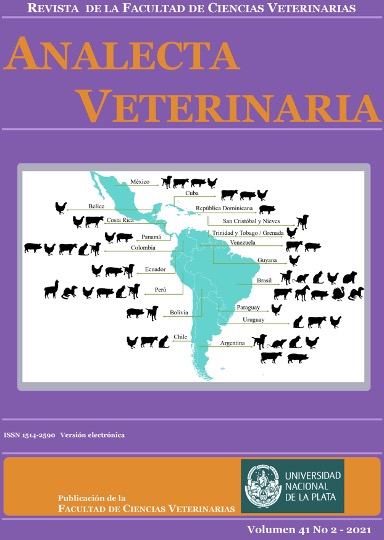Dog bite trauma resolution in tortoise (Chelonoidis chilensis) by skin approximation and use of honey
DOI:
https://doi.org/10.24215/15142590e058Keywords:
Chelonoidis chilensis, honey, trauma, Argentine tortoiseAbstract
A case of a male, adult tortoise (Chelonoidis chilensis) attacked by a dog is described. The animal presented a fractured plastron, with loss of the frontal segment, exposing the deltoideus and supracoracoideus muscles. Three hooks were fixed to the plastron with epoxy resin, approximating the skin to them with polyamide 0.30. Antibiotic treatment consisted in cefazoline, and the open spaces between skin and plastron were covered with honey every 48 hours. Growth of Fusarium spp. was detected at the 5th day on the surface treated with honey, therefore the topical treatment was modified by adding a daily washing with 7.5% povidone-iodine prior to the application of honey. In addition, water baths were performed for 2 hours, every 48 hours. The patient started drinking water and eating food at the 5th and 35th day, respectively. Good adherence of the skin to the muscles was observed at 28 days when, coincidentally, the patient began using the forelimbs. At 6 weeks, the sutures were removed, and a remodeling of the integument and a complete closure of the wound were observed.
Downloads
Metrics
References
Cabrera MR. 1998. Las tortugas continentales de Sudamérica Austral. Córdoba, edición privada del autor.
Carpenter JW, Marion CJ. 2018. Exotic animal formulary. 5º ed. St. Louis, Elsevier.
Grabowski NT, Klein G. 2017. Microbiology and foodborne pathogens in honey. Critical Reviews in Food Science and Nutrition. 57(9):1852-62. https://doi.org/10.1080/10408398.2015.1029041
Gray JE. 1870. Note on Testudo chilensis. Annals and Magazine of Natural History. (4)6:428.
Kačániová M, Kňazovická V, Felšöciová S, Rovná K. 2012. Microscopic fungi recovered from honey and their toxinogenity. Journal of Environmental Science and Health. Part A, Toxic/Hazardous Substances & Environmental Engineering. 47(11):1659-64. https://doi.org/10.1080/10934529.2012.687242
Mickelson M, Mans C, Colopy S. 2016. Principles of wound management and wound healing in the exotic pets. Veterinary Clinics of North America: Exotic Animal Practice. 19(1):33-53. https://doi.org/10.1016/j.cvex.2015.08.002
Negrini J, Ginel P, Novales M, Guerra R, Mozos E. 2016. Clinical and histological findings of cutaneous wound healing in the red-eared slider turtle (Trachemys scripta elegans) housed in unheated outdoor enclosures. Veterinary Dermatology. 27(5):413-e106. https://doi.org/10.1111/vde.12346
Paterson S. 2006. Skin diseases of exotic pets. Oxford, Blackwell.
Pereira Dutra GH. Testudines. En: Cubas ZS, Silva JCR, Catao-Dias JL. 2014. Tratado de animais selvagens. 2º ed. Sao Paulo, Roca, pp. 219-58.
Pintos S, González R, González E. 2015. Cicatrización de injertos cutáneos en malla de espesor completo utilizando azúcar granulado versus nitrofurazona en caninos. Revista Veterinaria. 26(2):103-07.
Romero F, Espinoza A, Salaberry-Pincheira N, Napolitano C. 2019. A five-year retrospective study on patterns of casuistry and insights on the current status of wildlife rescue and rehabilitation centers in Chile. Revista Chilena de Historia Natural. 92(6):1-10. https://doi.org/10.1186/s40693-019-0086-0
Scheelings T, Hellebuyck T. Integument. En: Divers S, Stahl S. 2019. Mader’s reptile and amphibian medicine and surgery. St. Louis, Elsevier, pp. 1042-43.
Van Dijk PP, Iverson J, Rhodin A, Schaffer B, Bour R. 2014. Turtles of the world, 7th edition: Annotated checklist of taxonomy, synonymy, distribution with maps, and conservation status. Chelonian Research Monographs. 5(7):329-479. https://doi.org/10.3854/crm.5.000.checklist.v7.2014
Vetter Hiebert JR, Riveros Núñez EH. 2021. Control de roedores sinantrópicos por ataques a tortugas terrestres, Chelonoidis carbonaria (Spix) y Chelonoidis chilensis (Gray), juveniles, en cautiverio. Boletín del Museo Nacional de Historia Natural del Paraguay. 25(2): 89-100.
Published
How to Cite
Issue
Section
License
Authors retain the copyright and assign to the journal the right of the first publication, with the with the terms of the Creative Commons attribution license. This type of license allows other people to download the work and share it, as long as credit is granted for the authorship, but does not allow them to be changed in any way or used them commercially.

Analecta Veterinaria by School of Veterinary Sciences, National University of La Plata is distributed under a Creative Commons Attribution-NonCommercial-NoDeriv 4.0 International License.

























